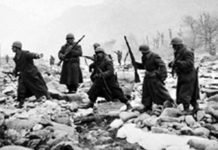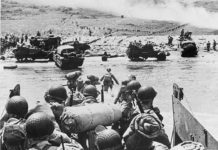In preparation for the Battle of the Little Bighorn, Major Marcus Reno lead a scouting party to locate the enemy Sioux and Cheyenne Indians.
As General George Crook prepared to locate a suspected Indian village prior to the Battle of the Rosebud, General Terry was closing in on the same quarry, albeit from a different direction. After meeting up with Colonel Gibbon on Montana’s Yellowstone River, Terry and George Custer had been informed about sightings of the village close by. Terry ordered some of his men to surveil the area to determine its location and approximate strength. With that done, he would send columns under Gibbon and Custer to crush Indian camp from opposing directions in a pincer movement.
Reno In Search of the Indians
Major Marcus Reno was to lead reconnaissance into the field and ensure that the village had not deviated from its steady migration west towards Rosebud Creek. He was to move up the Powder River, cross westward until reaching the Tongue River, and then follow it back down to the Yellowstone to meet up with the rest of the forces of Custer and Gibbon. Terry specifically ordered him not to go beyond the Tongue and explore the Rosebud (farther west) for fear of spooking the village or, worse yet, inciting a lopsided battle against Reno’s small force.
On June 10, 1876, Reno moved out with six companies of the Seventh Cavalry, several scouts, a Gatling gun, and 12 days of rations. After moving along the Powder River for two days, Reno moved west to the divide separating the Powder River and Mizpah Creek drainages. Seeing no sign of enemy activity, he continued west to the Tongue River. Arriving there, he discovered the former site of the massive enemy camp previously seen by Gibbon’s scouts on May 16. Reno’s main scout, Mitch Boyer, was privy to its location when it was initially discovered and when it was seen again on Rosebud Creek 11 days later. It appeared that the Indian camp was actually located further west than Terry thought.
Reno’s Disobedience Leads to Valuable Intelligence
With Boyer’s insight, Reno decided to disobey his orders of avoiding the Rosebud with the hope that by surveiling it, he could give General Terry better information as to the current location of the village. His column rode up the Rosebud on June 17. It discovered additional campsites and evidence of a large band of Indians on the move. His scouts estimated that they were within a day of overtaking the camp and that it likely resided in the next river drainage to the west. Fearing that he would tip the Indians off to his presence if he continued further, Reno turned to follow the Rosebud back to its confluence with the Yellowstone and link up with Terry. What Reno didn’t know was that on Rosebud Creek, Crook was battling warriors from the village he was tracking that same day 40 miles to the south. Neither Crook nor Reno was aware of the other’s location or activities.
After meeting up with Terry on June 20, Reno was scolded for disobeying orders. However, Terry quickly understood the value of what the major had discovered. Rather than pinning the Indian camp between the forces of Custer and Gibbon on the Rosebud as he had originally anticipated, Terry adjusted his plan to carry out a similar movement farther west to include the valley of the Little Bighorn.
On June 21, Terry briefed Custer and Gibbon on their respective marches to the Little Bighorn River. Custer would move up the Rosebud to its source. If no Indians were found, he would turn west and move down the Little Bighorn and send a message to Gibbon to proceed in that direction. Gibbon’s forces would station themselves at the mouth of the Little Bighorn. Terry anticipated that the camp would be trapped in between them and crushed. Four days later, the famed Custer and his Seventh Cavalry would meet their fate.








